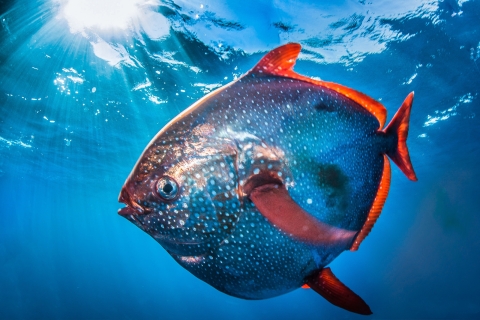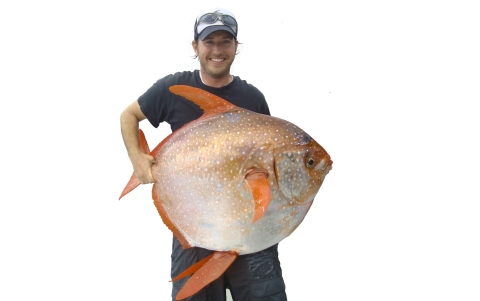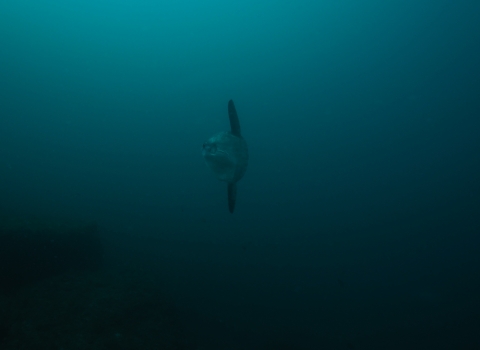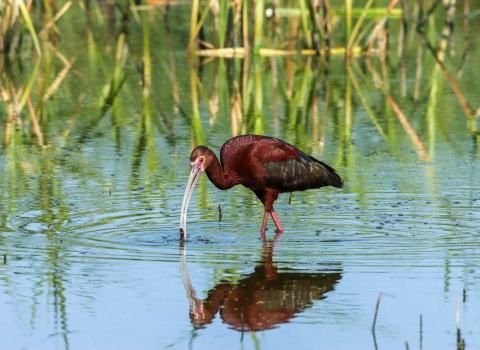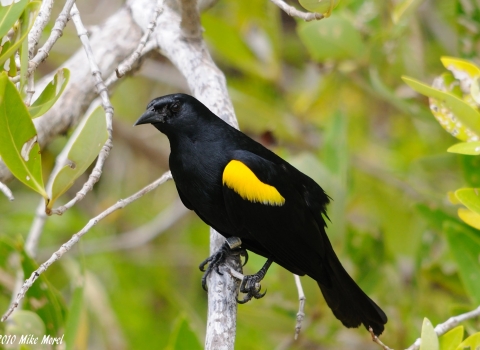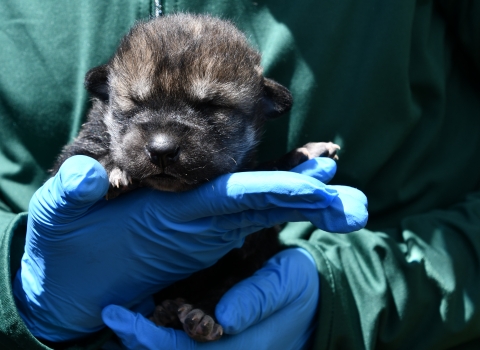The ocean is chock-full of athletic speedsters zooming around the depths in search of their next meal. Nature documentaries are full of epic footage featuring marlin, tuna, sharks, and other famous species streaking through the water to demolish some poor school of anchovies or herring. But athleticism in the marine environment comes in all sorts of unique shapes and sizes—and no fish exemplifies this better than the elusive and unmistakable opah!
Sun and Moon
Opah, or moonfish, have some similarities to a group of fish we’ve previously covered—molas, or ocean sunfish.
Opah are comprised of six known species in the genus Lampris. Opah and molas also share a similarly deep-bodied and round body shape. Both groups of fish are also far more athletic than their somewhat odd shape might suggest—opah are known to keep pace with tuna and other highly mobile predators during their forays throughout the mesopelagic zone, usually sticking within about 150-500 feet deep. And finally, both opah and molas utilize somewhat abnormal swimming methods. While molas wag their oversized dorsal and ventral fins to move forward, opah flap their pectoral fins to fly through the water in what’s known as a “labriform” swimming method. Though opah larvae are quite long and slender when hatched, they quickly grow into their distinctive deep-bodied form before they’re an inch long.
Massive pecs, a forked tail, fixed and rigid dorsal and ventral fins, and a flat head-on profile grant opah truly remarkable swimming endurance at high speeds. Though they aren’t known to school with members of their own species and their exact swimming speed is also uncertain, opah undertake long-range migrations similar to tuna and other pelagic fishes and are sometimes caught in the same areas.
Despite some similarities to other fish, opah are unmistakable in their appearance. Their white-speckled rosy orange bodies, bright crimson curved fins, large eyes, and iridescent coating make for a spectacularly gorgeous fish! While the largest species (the North Atlantic opah) can reach known weights of up to a couple hundred pounds, most of the opah caught are significantly smaller.
Hot Under the Collar
The distinct appearance of opah belies their truly unique biology. A rare few fish like tunas, billfish, and lamnid sharks can regulate the internal temperature of certain critical portions of their bodies. Opah take it one step further: they have the distinction of being the only known fish to possess whole-body endothermy, allowing them to maintain internal temperatures higher than the surrounding water throughout their entire body. In addition to their unique whole-body warming, they keep their eyes and brain even warmer.
“Think about an animal that's down at a depth that's warmer than the things that's eating. It can outperform them...it can swim around faster, respond quicker. It gives it a really distinct advantage.”
Unlike truly “warm-blooded” animals (including us humans) who maintain an internal temperature within a small range, the opah’s internal warmth does fluctuate significantly (opah can keep themselves about 6-8° C warmer than their surroundings). The large muscles opah use to power their pectoral fins are a large source of this internal heat, both through their own movement and unique internal structures that generate heat even in the absence of muscle contractions. Thick layers of fat tissue around the opah’s skull and organs further help, by insulating these critical areas against the cold of the deep ocean water around them.
While these factors certainly help, the opah’s endothermy is enabled primarily by another special adaptation. Since fish must pump blood to their water-exposed gills to take in fresh oxygen, the gills are the point of greatest heat loss in fish. Though the deoxygenated blood flowing from the heart to the gills is quite warm from its time inside the core of the opah’s body and would normally be cooled down significantly upon reaching the gills, a structure structure
Something temporarily or permanently constructed, built, or placed; and constructed of natural or manufactured parts including, but not limited to, a building, shed, cabin, porch, bridge, walkway, stair steps, sign, landing, platform, dock, rack, fence, telecommunication device, antennae, fish cleaning table, satellite dish/mount, or well head.
Learn more about structure called a rete mirabile (Latin for “wonderful net”) helps prevent this. The dense mesh of blood vessels within the rete mirabile lets the warm blood going to the gills exchange its heat with the cold and oxygenated blood returning from the gills, ensuring that the blood flowing to the opah’s internal organs is already warmed up to the ambient body temperature. Though this structure exists in some other fish, having a rete mirabile in the gills is one more biological asset totally unique to opah!
Delectable Deep-Dwellers
While their solitary nature makes direct commercial fishing for them a low-odds prospect, opah are valuable bycatch of many tuna or swordfish fisheries within their range. The pinkish-orange fillets from opah are known for their rich and meaty texture, and their relatively large size makes them a welcome sight any commercial fishing boat or fishmonger in the know!
In Hawaii, where their name originates, opah have long been celebrated for their place on the dinner table. They are also a rare but prized catch for recreational anglers plumbing the depths for bluefin or bigeye tuna off the coast of California, though opah species are found in tropical and temperate oceans worldwide. While the pinkish meat from their large dorsal muscles is comparable to tuna or swordfish, enterprising chefs in Hawaii and southern California have been experimenting with different cuts of opah meat from their dense, red pectoral muscles. Read more about their seven distinct types of meat.
Opah-tunistic Eaters
The lack of a large fishery for opah, combined with their deep-water habitat and tendency to seemingly avoid members of their own species, means that our scientific understanding of opah behavior and everyday life is quite limited. There is very little basic research on much of their basic biology and ecology, though NOAA has implemented biological sampling and electronic tagging programs for opah. Some of the results from these tagging operations have revealed that opah can fall prey to apex predators such as great white or mako sharks and large marine mammals, such as orca. Stomach content analyses indicate that opah themselves are opportunistic predators with very broad diets, happy to eat any small fish, squid, or crustacean they can catch (though squid and krill seem to make up the bulk of their prey).
“I have a friend that's been doing some diet studies on opah and he's found everything in there...like squid and fish...he found a lime wedge and half of onion!”
While there is currently no evidence that opah populations are overfished or an unsustainable seafood choice, our pool of opah information is relatively small and their populations have thus never been formally assessed. Dr. Wegner emphasizes the importance of fishing fleets in providing much of the basic data that researchers use to fill in the gaps in our understanding of them. In particular, opah researchers hope to better characterize their movement, spawning habits, and maturation/growth rates. Anyone wanting to report an opah catch, especially from recreational boats, can contact him or other researchers at the NOAA Southwest Fisheries Science Center.
So when you’re out enjoying #AllTheFish, don’t forget about the illustrious opah: labriform lone wolf and marathoner of the mesopelagic!
More Moon
Catch the conversation with Dr. Nick Wegner from our sister agency National Marine Fisheries Service on our award-winning podcast Fish of the Week! Apple Podcasts I FWS.gov. Further reading: Whole-body endothermy in a mesopelagic fish, the opah, Lampris guttatus I Clues At Fish Auction Reveal Several New Species Of Opah I Warm Blood Makes Opah Agile Predator
We honor, thank, and celebrate the whole community — individuals, Tribes, States, our sister agencies, fish enthusiasts, scientists, and others — who have elevated our understanding and love, as people and professionals, of all the fish. In Alaska we are shared stewards of world-renowned natural resources and our nation’s last true wild places. Our hope is that each generation has the opportunity to live with, live from, discover and enjoy the wildness of this awe-inspiring land and the people who love and depend on it.

